Isabel Moctezuma was an Aztec princess who lived during the time of the Spanish Conquest of Mexico. Isabel was the daughter of Moctezuma II, and by the time she was 11 or 12 years old, she had been married off not just to an Aztec noble, but also to two Aztec emperors. Following the fall of the Aztec Empire, Isabel was recognized as the legitimate heir of her father, and subsequently married three more times, this time to Spaniards, assuring a Spanish lineage for her ravaged Montezuma bloodline as the Aztec Empire lay in ruins.
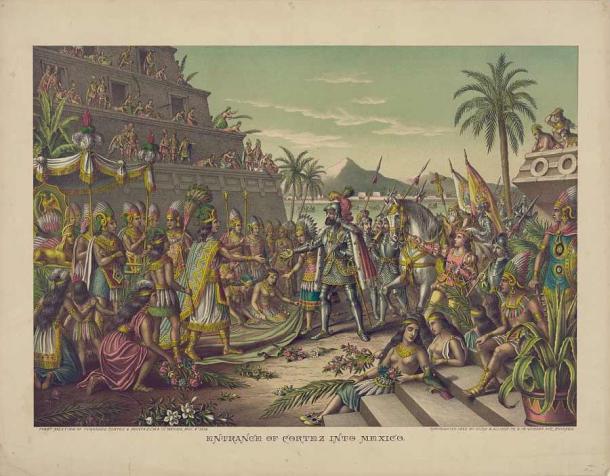
Moctezuma II, the father of Isabel Moctezuma, meeting Hernán Cortés. ( Public domain )
Isabel Moctezuma: The Emperor’s Most Valuable Commodity
Isabel Moctezuma was born around 1510, and was originally known as Tecuixpo Ixtlaxóchitl, Tecuichpo or Tecuichpochtzin, which has been translated to mean either “cotton flower” or “lord’s daughter.” She was the daughter of Moctezuma II, the 9 th ruler of the Aztec Empire. The identity of Isabel’s mother, however, is less certain. According to a contemporary Spanish historian, Francisco López de Gómara, Moctezuma had as many as 3,000 wives and concubines. According to another historian, the mestizo Fernando Alva Ixtlilxochitl, Isabel’s mother was Tayhualcan, the emperor’s chief wife. Ixtlilxochitl adds that Tayhualcan was the daughter of Totoquihuaztli, the last pre-Hispanic ruler of Tlacopan.
The Aztecs, along with other pre-Hispanic Mesoamerican cultures, believed that a person possessed the essence of both his or her parents. This meant that even the daughters of rulers were highly valued, as it was also believed that they were able to transmit the essence of their parents to their husbands. Thus, being the daughter of an Aztec emperor and his chief wife, Isabel was considered to be a particularly high-status individual, and was therefore especially valuable as a wife.
Shortly before the fall of the Aztec Empire, Isabel was married to the Aztec nobleman Atlilxcatzin, who was the son of Ahuitzotl, Moctezuma’s predecessor. The relations between the two of them meant that Isabel’s husband was also her cousin and maternal uncle. When they were married in 1519, Isabel was still a child. The marriage, however, was not to last for long, as Atlilxcatzin was dead by 1520. By the time Isabel was widowed for the first time, the Spanish, under the conquistador Hernán Cortés , had arrived in Tenochtitlan, the capital of the Aztec Empire.
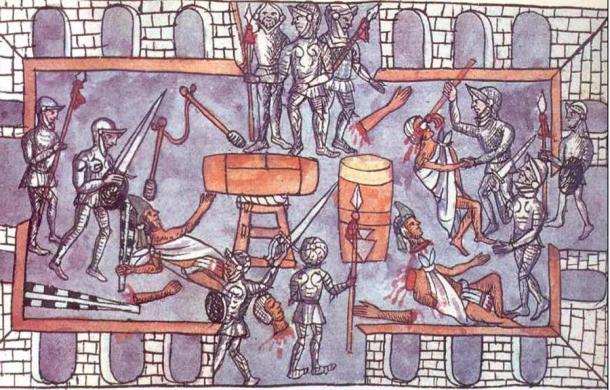
Tensions grew between the Spanish and the Aztecs, culminating in a massacre of Aztec elites in the Great Temple of Tenochtitlan at the hands of the Spanish during the Festival of Toxcati in 1520. ( Public domain )
Arrival of Hernán Cortés and the Fall of the Aztec Empire
Moctezuma had the great misfortune of being on the Aztec throne at the time of Cortés’ arrival. The emperor was keen to have peaceful and friendly relations with the Spanish, and therefore sent them Isabel, allegedly his favorite daughter, along with two of her half-sisters. It is thought that the three of them were sent as hostages, concubines, or both. This was supposed to have been a common custom amongst pre-Hispanic Mesoamericans and was meant to secure alliances.
Ultimately, however, the arrival of Hernán Cortés and his men brought only death to Moctezuma and destruction to the Aztec Empire. Although the emperor initially hosted the Spanish in his palace, he later became their prisoner. According to one version of the story, this occurred after the massacre in the Great Temple of Tenochtitlan. At that time, Cortés was not in the Aztec capital, as he had gone to fight Pánfilo de Narváez, a fellow conquistador who was sent to arrest him. During Cortés’ absence, tensions grew between the Spanish and the Aztecs, culminating in the massacre of the Aztec elites whilst they were celebrating the Festival of Toxcatl in the Great Temple. The massacre is recorded to have happened on the 22 nd of May 1520.
Since the Spanish were greatly outnumbered by the Aztecs, and knew that they were trapped in the city, they decided to take Moctezuma hostage, believing that the Aztecs would not attack them as long as they had the emperor in their hands. By the 1 st of July 1520 (or a day or two before that), however, the emperor was dead.
According to the Spanish account, Moctezuma had attempted to speak to his subjects in order to pacify them. The emperor’s submission to the Spanish, however, greatly reduced their reverence for him. Therefore, they began to pelt him with stones and arrows. Consequently, Moctezuma died of his injuries three days later. The Aztec account, on the other hand, claims that the emperor was murdered by the Spanish once they realized that he had outlived his usefulness.
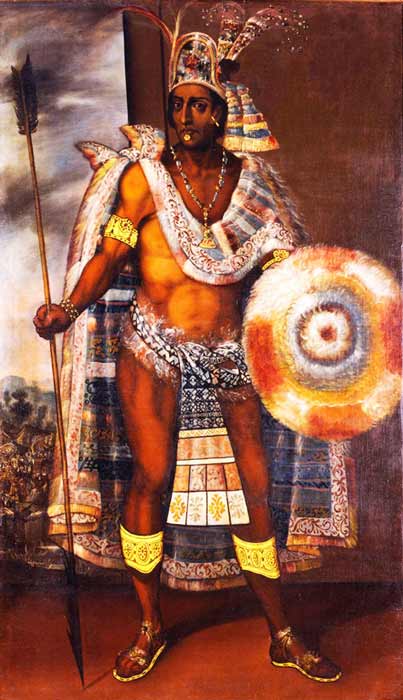
The Spanish took Moctezuma II hostage, and by 1 July, 1520, he was dead. ( Public domain )
Cuitláhuac Becomes Aztec Emperor
Around the same time, the Aztecs had chosen Cuitláhuac, the emperor’s brother, to lead them. Unlike Moctezuma, Cuitláhuac was hostile towards the Spanish, and was determined to get rid of them from his city. Therefore, although the Spanish held Moctezuma hostage, they were also being besieged by the Aztecs. The Spanish were eventually expelled from Tenochtitlan during La Noche Triste (known as “The Night of Sorrows”). This incident occurred on the night of 30 th of June 1520, just before Moctezuma’s death. The food supply of the besieged Spaniards was dwindling, and therefore Cortés decided to flee from the city with his men. If the Spanish version of events were to be believed, Moctezuma’s death also contributed to the Spanish decision to flee. On the other hand, if the Aztec version of events were accepted, Moctezuma was killed by the Spanish when they chose to flee.
During the Spanish retreat, Cortés and his men were attacked by the Aztecs when they were crossing the Tacuba causeway, as they had been spotted by a local woman, who raised the alarm. Consequently, the rearguard of Cortés’ army was almost completely wiped out by the Aztecs, his Tlaxcalan allies suffering the heaviest casualties. Many of the men were killed by the Aztecs, or drowned in the lake. Those who were captured were subsequently sacrificed.
Following the expulsion of the Spanish, and the death of Moctezuma, Cuitláhuac became the new Aztec emperor. One of the things he did, perhaps to legitimize his rule, was to marry his niece, Isabel. Like her first marriage, this one did not last for long either. As the new emperor, Cuitláhuac sought to form a coalition with neighboring tribes against the Spanish. Unfortunately, these tribes hated the Aztecs even more, and therefore refused to come to their aid. In any case, Cuitláhuac only ruled only about 80 days before succumbing to smallpox, which had been brought to the New World by the Spanish.
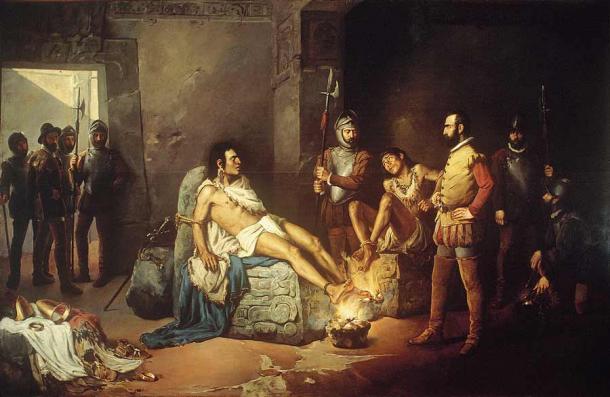
Cortés supposedly interrogated Cuauhtémoc and other indigenous nobles before having them executed in 1525. ( Public domain )
Cuauhtémoc: Husband Number Three and Last Aztec Emperor
In the meantime, Cortés had regrouped his men, and in May 1521, was back at Tenochtitlan. By then, the Aztecs had yet another new emperor, Cuauhtémoc, the last ruler of the Aztec Empire . He was a nephew of Moctezuma, and like his predecessor, married Isabel as well. Cuauhtémoc is perhaps best remembered for his resistance against the Spanish. In spite of the fierce resistance that the Aztec put up against the Spanish, Tenochtitlan finally fell to Cortés in August 1521. The emperor himself was captured when he was trying to cross the lake in disguise. He was on a mission to obtain help from the countryside.
Following his capture, Cuauhtémoc surrendered to Cortés, and even offered him his own knife, so that the conquistador may put an end to his life. Instead of killing the Aztec emperor, however, Cortés spared Cuauhtémoc, and even treated him courteously. Cortés’ respect for the emperor’s valor, however, was overruled by his belief that Cuauhtémoc knew the location of hidden treasures. Therefore, he allowed his men to torture Cuauhtémoc in order to get this information out of him. Cuauhtémoc insisted that there was no such treasure, and bravely endured the tortures.
Eventually, Cortés felt ashamed of his treatment of the emperor, and released him. Although some gold was found in the house of one of the Aztec nobles, the myth that the Aztecs were hiding vast amounts of gold was shattered. Cuauhtémoc was kept alive for several years after his capture. In 1525, Cortés embarked on an expedition to Honduras, and took Cuauhtémoc along with him, for fear that the former emperor would use the opportunity of his absence to rally the Aztecs to rebel against the Spanish. During the expedition, however, Cortés ordered Cuauhtémoc to be executed. Thus, Isabel became a widow for the third time.

Isabel Moctezuma was exploited as Moctezuma’s most valuable commodity due to her power to transmit the “essence” of her bloodline to her husbands. ( INAH)
Doña Isabel and her Marriages to Spaniards
Although Isabel was regarded by the Spanish as the principal heir of Moctezuma, it seems that she was not viewed as a threat like her late husband, Cuauhtémoc. Moreover, as a member of the Aztec royal family, she was treated with much respect by the Spanish. Having said that, there may have been a political dimension to this as well. In 1526, Isabel, now known as Doña Isabel was wedded to Alonso de Grado, one of Cortés’ allies. This union, Cortés believed, served both the Spanish and the Aztecs, bringing them together as a new people. Isabel received a generous dowry, which included lands, and the services of other natives. The latter was a rather unusual endowment, which at that time was granted to only two other natives, both of whom were Isabel’s half-siblings.
In the following year, however, Isabel’s first Spanish husband died, and she was married once again, this time to Pedro Gallego de Andrade. Prior to that, however, Isabel was returned to Hernán Cortés , who, incidentally, was also a widower by that time. It is unknown if Isabel was forced to become Cortés’ mistress, or if she was seduced by him. In any case, she became pregnant and gave birth to her first child, a daughter by the name of Leonor Cortés de Moctezuma. As soon as Cortés learned that Isabel was pregnant, he sought a husband for her, so as to avoid any scandal. Thus, Isabel and Pedro Gallego were married. Although Cortés did not initially recognize his daughter with Isabel, he eventually accepted her.
Isabel and Pedro Gallego had a son, Juan de Andrade Gallego Moctezuma, who was born around 1529. In 1531, however, Pedro Gallego died, and Isabel was left in an economically difficult position. Although, as mentioned earlier, she received a generous dowry for her marriage to Alonso, Pedro Gallego had been using his wife’s fortunes as his own. Additionally, as a woman and a native, she was still regarded as an inferior by the Spanish, despite being of noble blood. It seems that her best chance of survival was to marry someone who was able to protect her interests. Thus, not long after Gallego’s death, Isabel married Juan Cano de Saavedra. It appears that this time Isabel chose her partner of her own accord, since Juan Cano was not an associate of Cortés.
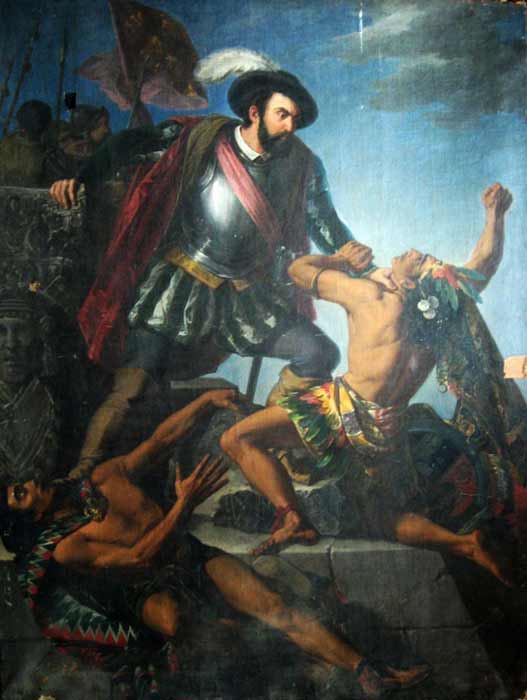
Painting of Hernán Cortés, who murdered Isabel’s father and brought the downfall of the Aztec people, fathered one of her children. ( Public domain )
Defending her Inheritance and the Moctezuma Lineage
The marriage benefitted both Isabel and Juan Cano. On the one hand, Juan Cano, though his marriage to Moctezuma’s principal heir, enjoyed a rise in his social status. On the other Isabel found someone who would represent and protect her interests. Even before her marriage to Juan Cano, Isabel had been plagued by claims to the lands given to her as part of her dowry. These continued even after her last marriage, but this time, she had someone to defend her property with her. Between 1531 and her death around 1550, Isabel was involved in three lawsuits, and managed to win all three of them.
The ultimate goal for both Isabel and her husband was the restitution of all the lands, settlements, and other objects of value that were once owned by Moctezuma. Unfortunately, Isabel died whilst the lawsuit was ongoing. In 1556, the inheritance rights of Isabel and here descendants to all the disputed lands and settlements were confirmed by the Royal Audiencia of Mexico City. This confirmation, however, was purely a formality, as the judges also acknowledged that it was practically impossible to restore these properties to her and her descendants. These properties were already in the hands of other individuals, and to dispossess them would greatly upset them.
Lastly, although Isabel failed in her mission to reclaim her father’s domains, she succeeded in founding a line of Spanish nobility. Her youngest son, Juan Cano de Moctezuma, went to Spain, where he embarked on an impressive career. In addition, he was recognized by the Spanish Crown as the legal heir of Moctezuma. Furthermore, he married Elvira de Toledo, who was from a prominent Spanish noble family, and gave rise to the line of Toledo-Moctezuma. The descendants of Isabel also married into other Spanish noble families, thus, in a way, keeping alive the lineage of the Aztec emperors.
Top image: The tragic exploitation of Isabel Moctezuma, the most valuable asset of her late father Moctezuma II, led to six marriages against the backdrop of the decimation of the Aztec Empire. Source: delbars / Adobe Stock
By Wu Mingren
Related posts:
Views: 0
 RSS Feed
RSS Feed

















 April 21st, 2021
April 21st, 2021  Awake Goy
Awake Goy  Posted in
Posted in  Tags:
Tags: 
















